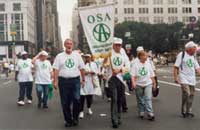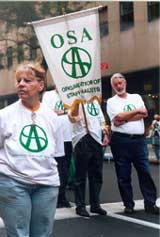News From OSA - October, 2000
This edition of News From OSA on our website includes material from both the September and October mailings to members. First, lots of "Star Wars" type news.
 The Dark Side. . . Negotiations are at a standstill for most City unions as we watch the drama of the UFT vs Rudy. In one corner, we have Rudy (Darth Vader?) and a demand that the teachers give up transfer rights, job security, due process, raises to offset inflation, and their traditional hours of work; all in return for an unspecified merit raise.
The Dark Side. . . Negotiations are at a standstill for most City unions as we watch the drama of the UFT vs Rudy. In one corner, we have Rudy (Darth Vader?) and a demand that the teachers give up transfer rights, job security, due process, raises to offset inflation, and their traditional hours of work; all in return for an unspecified merit raise.
In the other corner, our champion, Randi Weingarten (otherwise known as Princess Leia and
head of the Municipal Labor Committee as well as President of the UFT), awaits a serious offer.
 There exists a remote possibility that the Mayor is serious, since he did publicly favor merit raises to the exclusion of cost of living raises before he was elected. After he was in office, we did eventually obtain raises to balance the rise of inflation but we also got two years of zero-zero first.
There exists a remote possibility that the Mayor is serious, since he did publicly favor merit raises to the exclusion of cost of living raises before he was elected. After he was in office, we did eventually obtain raises to balance the rise of inflation but we also got two years of zero-zero first.
Many union leaders now swear that they will not accept another contract starting with zeros, and there is little doubt that such oaths are sincere, especially, perhaps, in the case of the teachers. So then, since the strength of all of the organized city workforce is easily sufficient, united as we are to compel a reasonable raise from a flush City, why is the City wasting time offering nothing for something?
The answer may be term limits. The Mayor will not have to govern New York City past January, 2002. If he is now taking the position of Louis XIV of France "Apres moi, le deluge" or, after his term, disaster follows, we could be in for a long wait.
 Since the Mayor is never going to get the unions to agree to entirely discretionary raises handed out without any objective criteria, all he need do is to continue his bargaining posture for another year and the effect will be another zero-zero on his watch. To be sure, any successor to the Mayor would be likely to settle the contracts retroactively, so we would not end up with zeros, but the discomfort of delayed and uncertain raises would have already occurred.
Since the Mayor is never going to get the unions to agree to entirely discretionary raises handed out without any objective criteria, all he need do is to continue his bargaining posture for another year and the effect will be another zero-zero on his watch. To be sure, any successor to the Mayor would be likely to settle the contracts retroactively, so we would not end up with zeros, but the discomfort of delayed and uncertain raises would have already occurred.
Our negotiations at the Transit Authority are going – to be kind – slowly. We want our members at TA to get the longevity given to all unionized Analysts and the TA wants
to discuss discretionary raises.
 We have asked that the objective criteria for "merit" raises be set forth, asked how much was given as merits the year before unionization was achieved and asked what the total value of the package offered would be.
We have asked that the objective criteria for "merit" raises be set forth, asked how much was given as merits the year before unionization was achieved and asked what the total value of the package offered would be.
We have, to date, not been told of a single concrete penny being placed on the table by the TA, but we have learned their position on our other demands. They can't imagine why we are insisting on due process, with serious cases decided by an arbitrator. Instead, they prefer a status quo situation with all final decisions left to management's discretion. Our demands for full continuation of both health and education benefits was met with an initial response of the TA offering to exchange those benefits for DC 37 equivalent benefits. The subsequent response by TA was a little better. They promised to get us figures on education monies given out last year or the year before and offered to put a cash value on the difference between current health plans and proposed plans, in case the union could pay a part of the difference.
The one victory we have won is an agreement to allow 401K members to continue in their chosen savings plan, but, while welcome, that decision alone does not a contract make.
Remember The Force. . . The power of the New York City work force is quite enough to handle Darth Mayor but as we all know, the strength of the Dark Side is gre at and our struggle may be long.
at and our struggle may be long.
OSA has negotiated contracts with this administration before and although we have always had a very hard time, we eventually won most or all of our demands.
The prior contract that took us the longest to negotiate (so far) was our effort at HHC in the nineties. We had filed to organize Systems Analysts in 1992 – and won the right to represent most of them by 1994. It still took nearly three years of tough negotiations, followed by impasse proceedings, to squeeze out the partial victory we won at that time. We had wanted both the ten and 15 year longevities. We got the $700 15-year differential, but did not obtain the $379 10 year amount.
There were many impatient members at HHC who had been willing to settle earlier. They had, after all, not been given a raise since 1991. The City did offer the 7.16% increase due for that period if we would drop the demand for longevity, but OSA held out for the full raise and, eventually, we got most of it. The small amount not won in that contract was given in the next. Our Analysts who were finally able to collectively bargain in 1994 have pulled ahead by differentials of between one and three thousand dollars, depending on length of service. It was worth the wait.
 Remember the power of the workforce can and will give us all a fair raise and decent conditions. We must stay united, understand, and make use of our own power.
Remember the power of the workforce can and will give us all a fair raise and decent conditions. We must stay united, understand, and make use of our own power.
One small left over symbol of our past triumphs in negotiations is still on hand to put money in our pockets. It is a complex story to tell.
Many years ago and in a universe that seems now far, far away, the MLC was able to complete the creation of GHI/CBP health plan. If HIP, as an HMO, has been popular long term with over 30% of City employees, GHI/CBP, as a point of service (pick your own doctor) plan, has been even more popular with a 60% sign up rate. But...there was a problem.
The City was willing to fund the basic HIP rates, but GHI cost increases, for the early years, could have been greater than the HIP increases. A stabilization Fund was created and the City agreed to contribute extra dollars to increase the amount used to pay GHI/CBP costs. The amount set aside by the agreement was determined in part by the percentage of the provider rates increases allowed by New York State to HIP.
 As our members are sadly aware, the HIP increases of recent years have been huge but, given changes in the health care field, GHI/CBP increases have been lower. The result is a surplus in the Stabilization Fund estimated at about $300,000,000. This money is ours.
As our members are sadly aware, the HIP increases of recent years have been huge but, given changes in the health care field, GHI/CBP increases have been lower. The result is a surplus in the Stabilization Fund estimated at about $300,000,000. This money is ours.
Recently, Jim Hanley, head of the City office of Labor Relations, approached the MLC Technical Health Subcommittee, and then the MLC Steering Committee with a "wonderful" offer.
The City knew how big the Stabilization Fund had grown, and had come up with a list of novel ways to spend any surplus accumulation. They might for example agree to using some of that money to help out union welfare funds and, in return, we would forgive them some of their future contractually obligated payments.
We turned down the offer thus far and have some counter offers of our own to suggest, (ones that skip the part about letting the City pick our pockets). Basically, we have told Jim we are awaiting some progress on new union contracts. Still, it is nice to know that there is some money acknowledged as being on the table at last, even if it is money we note to be ours already.
 And On the Bright Side . . . Our union may be locked in contract battle at the TA, but we have already been of major help to one of our own. There was a recent Metrocard scandal in the newspapers. One of the employees selling the cards came up with a trick to steal money and was eventually apprehended. Next came the search for the flaw in the system that allowed such thieving to go unnoticed.
And On the Bright Side . . . Our union may be locked in contract battle at the TA, but we have already been of major help to one of our own. There was a recent Metrocard scandal in the newspapers. One of the employees selling the cards came up with a trick to steal money and was eventually apprehended. Next came the search for the flaw in the system that allowed such thieving to go unnoticed.
Ah ha! The TA decided it was all the fault of a Staff Analyst who had not done her job properly. They suspended and prepared to fire her.
"Not so fast" was the response of the Organization of Staff Analysts. First, we noted that any system so poorly designed that a single unchecked employee's neglect could cost the TA millions was no great system in the first place. Then we got to the particular case itself and determined to our own satisfaction that the member had not even been properly trained from the start.
 Curiously, the ferocity of the response by our grievance section surprised the TA Labor Relations and Human Resources personnel. The TA re-investigated the case and reconsidered their approach. A compromise was negotiated based on their findings subsequent to OSA's reaction and our member was restored to payroll. She is at a different analytical job in the TA at present.
Curiously, the ferocity of the response by our grievance section surprised the TA Labor Relations and Human Resources personnel. The TA re-investigated the case and reconsidered their approach. A compromise was negotiated based on their findings subsequent to OSA's reaction and our member was restored to payroll. She is at a different analytical job in the TA at present.
The TA has begun to learn who we are, and we, in truth, are beginning to see some positive aspects to the TA as an employer. Recently the OSA Chairperson stood next to the TA President on a receiving line. It was no marriage that brought them together, but a TA ceremony honoring 20, 25 and 30 year veterans.
The curious but really rather nice custom at such affairs is for each awardee to go down the line being congratulated by both union representative and also by management as well. The TA President Larry Reuter shook every employee's hand as he stood there, and well over two hundred hands were offered.
 We are a long way from accepting a handshake instead of a contract, but we do note the efforts taken by the TA top leadership to show appreciation for long service. Maybe we will get that longevity without trading our eye teeth for it.
We are a long way from accepting a handshake instead of a contract, but we do note the efforts taken by the TA top leadership to show appreciation for long service. Maybe we will get that longevity without trading our eye teeth for it.
"Pataki" 2 and Early Retirement Incentive . . . Richie Guarino, one of our expert pension mavens (and a rumored Jedi Knight as well) is on top of the recent negotiations for an early retirement incentive. The final details as to who is eligible are being negotiated, but some elements are clear now. The offer is the standard one month of pension credit extra for every year served (up to 36), but there is a twist for Tier I & II. If you are in the early tiers you are now allowed to count the "Pataki" 2 years bonus won earlier this year towards completion of the 25 years needed. Thus if you were a Tier I member, who joined in 1970, but took a few child care leaves and now have only 24 years of service, you can opt out and collect as if you had worked a full 28 years.
 Coming Up . . . ASA Training . . . Our Jedi Training Master, Sheila Gorsky (otherwise known by the code name of Yoda) announces that DCAS (the Dept of Citywide Administrative Services) is scheduling the next ASA exam and she will be providing training for all OSA or OSART members interested.
Coming Up . . . ASA Training . . . Our Jedi Training Master, Sheila Gorsky (otherwise known by the code name of Yoda) announces that DCAS (the Dept of Citywide Administrative Services) is scheduling the next ASA exam and she will be providing training for all OSA or OSART members interested.
The exam will be promotional only, and preparations will begin once we have learned, from DCAS, the general content and format of the exams to be given. One point we will make is to urge a closer match between the offering announcement and the actual exam. There is no point in torturing thousands of candidates by asking them to study up on areas that do not appear on the final exam.
Labor Day Parade . . . The power of the force was most evident on September 9th as the OSA contingent marched proudly up Fifth Avenue, for the first time, a part of the NYC Labor Day parade.
Our tee shirts had a huge green OSA symbol on the front and "MLC 2000. We all deserve respect and a fair raise." on the back. It was a lovely day. This was our first participation, but we learned how it works and next time we will be out in greater force.
 We probably missed a few but here are the names of some of the folks who showed up.
We probably missed a few but here are the names of some of the folks who showed up.
Gilberte Ambroise, Tom Anderson, Patsy Balfour, Michell Burke, Ida Chin, Joan Doheny, Louis Duplan, Tom Geraghty, Sheila Gorsky, Shirley Gray, Richie Guarino, John Harper, Bea Keshner, Tony Lee, Marvin Lutenberg, Michael Mackey, Eric Mayr, Sheila McMahon, Al Milton, Steve Parker, Dolores Parson and Cheyenne, Ann Marie Paul, Paul Pelequin, Althea Samad, Ana Sanchez, David Smallwood, Michael Spector, Rob Spencer, Joe and Earline Sperling, Jay Warshofsky....and guests.
The photos throughout this edition of "News from OSA" are of OSA's Labor Day Parade contingent. Get in the picture next time.
Retirement Wisdom . . .OSA, as an institution, has been very consistent for many years but our membership changes all the time. Always welcome, new members coming on board do not know the same facts that the rest of us know. So, to one extent, union newsletters must often revisit old wisdom.
 The retirement system is one topic that younger members will often disdain, but they are wrong. The pension system is the best "predictable" investment most of us can find. The vesting is only five years, with full refund of contributions with generous interest if you don't make the five years, and the payout is actuarily subsidized from the start.
The retirement system is one topic that younger members will often disdain, but they are wrong. The pension system is the best "predictable" investment most of us can find. The vesting is only five years, with full refund of contributions with generous interest if you don't make the five years, and the payout is actuarily subsidized from the start.
Pension counseling is free to union members and if you are curious, call George Morgan to make an appointment.
Your Welfare Is Our Concern . . .A further area of concern, endlessly voiced, is our union's Welfare Fund. OSA chose to adopt the Management Benefits as our own, partially because we were accustomed to them. New members, arriving from other titles are, of course, accustomed to their prior union's plans. They miss their lost benefits and are not yet aware of the value of these new benefits.
New members often assume union dues and Welfare Fund benefits are related when they are not. Recently, however, OSA faced a collective bargaining election against DC37 in the hospitals. DC37 strongly campaigned, citing their drug plan, tuition reimbursement and legal services plan, all of which are certainly fine benefits. We responded with the enclosed letter.
hospitals. DC37 strongly campaigned, citing their drug plan, tuition reimbursement and legal services plan, all of which are certainly fine benefits. We responded with the enclosed letter.
The letter is being reproduced since it explains the issue fairly. As members are aware, we did win the final vote by almost a three to one margin. Of course, we have no idea if the members were voting for our Welfare Fund or our union.
REPRINTED FROM THE HHC CAMPAIGN
May 10, 2000
Dear Brothers and Sisters,
The issue that is of interest to Supervising Systems Analysts is their future Welfare Fund.
At present, all Supervising Systems Analysts are covered by the Management Benefits plan. Once the election has been held, all members will be transferred into either the DC 37 Health and Security Plan or the OSA Welfare Fund, depending on which union was chosen by the majority of Analysts voting.
All three plans are equally funded on a per member basis at $1275 per year. All three plans are valuable and designed to meet their members' needs.
 The OSA membership, a dozen years ago, had the choice of using their contractually awarded money to either imitate an existing plan or to design their own. We chose to mirror one of the existing models, but the question was, which plan to match? We examined five plans, Teamsters Local 237, CWA Local 1180, SSEU Local 371 DC37 and the Management Benefits plan. All of the plans were somewhat different in terms of benefits provided, but not one of them could be said to be absolutely better than the others. We chose, finally, to match the Management Benefits Plan and we have done so from that day to this.
The OSA membership, a dozen years ago, had the choice of using their contractually awarded money to either imitate an existing plan or to design their own. We chose to mirror one of the existing models, but the question was, which plan to match? We examined five plans, Teamsters Local 237, CWA Local 1180, SSEU Local 371 DC37 and the Management Benefits plan. All of the plans were somewhat different in terms of benefits provided, but not one of them could be said to be absolutely better than the others. We chose, finally, to match the Management Benefits Plan and we have done so from that day to this.
Our reasons for choosing the Management Fund as our model were understandable in 1988, and are the same today. Our first reason was simple. We all liked the Management Fund's benefits. Our dental plan was the best available, the optical benefit was most generous, the long term disability plan was fine, the superimposed major medical a life saver in times of extreme poor health and the life insurance amount was high enough to satisfy our desires in that area.
 Our second reason was a bit unusual and unique to us. In 1988, we knew our job was not done. We were dedicated, as a group, to spreading collective bargaining rights and civil service protection to all Analysts throughout the City. If we were to succeed, we would not want each group of new members to be inconvenienced, on arrival, by dramatic changes in their benefits.
Our second reason was a bit unusual and unique to us. In 1988, we knew our job was not done. We were dedicated, as a group, to spreading collective bargaining rights and civil service protection to all Analysts throughout the City. If we were to succeed, we would not want each group of new members to be inconvenienced, on arrival, by dramatic changes in their benefits.
As matters turned out, we have been very content with our choice. The Management Benefits plan has improved over the years. As it has improved, we have matched each improvement.
There was one benefit provided by most union plans that was not provided by the Management plan – prescription drug coverage. Instead, members of the Management plan enrolled in a prescription rider offered by GHI, HIP or one of the other health plans.
 As each new group of Analysts was given collective bargaining status, new members, familiar with the majority of the union plans, were both pleased that they had not lost their managerial plan benefits, yet they were also hopeful that OSA would provide a union sponsored drug plan as well. We could not do so. Either OSA uses its $1275 per person/per year to match the managerial plan or we use the money to match some other plan. We can't do both on the same $1275.
As each new group of Analysts was given collective bargaining status, new members, familiar with the majority of the union plans, were both pleased that they had not lost their managerial plan benefits, yet they were also hopeful that OSA would provide a union sponsored drug plan as well. We could not do so. Either OSA uses its $1275 per person/per year to match the managerial plan or we use the money to match some other plan. We can't do both on the same $1275.
If we were to allocate $500 to $600 per member/per year needed to fund a drug plan, our dental, optical, major medical, life and disability insurance would all have to be cut back. The simple fact is that most members have preferred us to continue as we started, and we have.
Currently, representatives of DC 37 have been arguing in favor of a vote for DC 37 based upon their drug benefit. There is no question that a prescription drug card is a good benefit and we would like to have one ourselves if it was in addition to our existing benefits. The problem is that the cost of maintaining the union drug plan has, in all cases, eroded all other available benefits. Worse still, through no fault of DC 37, the insane spiral of prescription drug costs that is occurring in this country is making it very hard for any union to sustain their plans at current levels.
 Even though OSA's Welfare Fund does not include a drug plan as such, we have also been affected by the rising costs in two ways.
Even though OSA's Welfare Fund does not include a drug plan as such, we have also been affected by the rising costs in two ways.
First, the superimposed major medical is not specifically a drug plan, but the cost of drugs is one component of the medical costs for which we do offer assistance after those costs exceed $500 in any year. There have already been two cases where our fund paid out more than $50,000 in a single year on behalf of a member in need of costly chemotherapy.
Second, since OSA members pay for a drug rider, any problems related to those riders become a legitimate concern of our union. Thus, when in 1999 GHI did a poor job of implementing a new cost saving mail order system, it was OSA that pulled together the "Easy Rider" coalition of unions. We intended to force GHI to be more responsive to its customers (us). As a result of our organizing the coalition, Municipal Labor Committee Chairperson, Randi Weingarten, put our concerns before all of municipal labor at the annual convention of City labor leaders. The result was the placement of representatives of our coalition onto the Health Technical Subcommittee of the MLC. As committee members, should GHI not respond to our complaints, their future business with NYC could be in jeopardy. This will not result in our being able to dramatically hold down the cost of drugs. That problem is national and serious, but at least we can control the delivery of our benefit by the vendors. In that respect we have served our members, the members of a dozen other unions and the managerial employees association well.
labor leaders. The result was the placement of representatives of our coalition onto the Health Technical Subcommittee of the MLC. As committee members, should GHI not respond to our complaints, their future business with NYC could be in jeopardy. This will not result in our being able to dramatically hold down the cost of drugs. That problem is national and serious, but at least we can control the delivery of our benefit by the vendors. In that respect we have served our members, the members of a dozen other unions and the managerial employees association well.
If a comparison were to be made between the DC 37 plan and the OSA plan, it would be a bit like comparing apples and oranges, both fruits and both appealing, but somewhat different. The DC 37 plan is clearly better for less well paid employees than is the OSA or Managerial plans. DC 37 has a short-term disability benefit worth up to $200 per week for up to 26 weeks. OSA's long-term disability will provide nothing for the first six months, but does pay $1000 per month thereafter until you are in actual receipt of Social Security disability and/or pension disability. The average waiting time for government approval is well over a year. Our plan also pays at least $150 per month even after our members are approved for disability payments from the government.
In addition, both the managerial plan and the OSA plan cover members who are ill with an extra full year of health and welfare fund benefits paid for by the plans. (The value of that benefit is about $3,000 to $4,000 for singles and $5,000 to $6,000 for families, depending upon health plan chosen.)
is about $3,000 to $4,000 for singles and $5,000 to $6,000 for families, depending upon health plan chosen.)
On the other hand, it could be argued, the OSA and Managerial plans are well tailored to our somewhat more middle class incomes. We do not wish to exhaust our savings to qualify for Medicaid. To avoid that possibility, our superimposed major medical benefit is a real value to us. Many of us will never obtain even one cent in benefits from the major medical, and thank goodness. We are the lucky ones. Nonetheless, it is important for all of us to know that if we or any member of our family has a truly serious and very costly illness, help is available without the need of total impoverishment first.
Perhaps, the strongest argument against our changing plans is an emotional one. We are used to the current plan and like it a lot. We are not opposed to change if it is clear that we will come out ahead, but we are not anxious to give up or diminish the quality of a single one of our existing benefits.
Fraternally,
Bob Croghan
This edition of News From OSA on our website includes material from both the September and October mailings to members. First, lots of "Star Wars" type news.
 The Dark Side. . . Negotiations are at a standstill for most City unions as we watch the drama of the UFT vs Rudy. In one corner, we have Rudy (Darth Vader?) and a demand that the teachers give up transfer rights, job security, due process, raises to offset inflation, and their traditional hours of work; all in return for an unspecified merit raise.
The Dark Side. . . Negotiations are at a standstill for most City unions as we watch the drama of the UFT vs Rudy. In one corner, we have Rudy (Darth Vader?) and a demand that the teachers give up transfer rights, job security, due process, raises to offset inflation, and their traditional hours of work; all in return for an unspecified merit raise.In the other corner, our champion, Randi Weingarten (otherwise known as Princess Leia and
head of the Municipal Labor Committee as well as President of the UFT), awaits a serious offer.
 There exists a remote possibility that the Mayor is serious, since he did publicly favor merit raises to the exclusion of cost of living raises before he was elected. After he was in office, we did eventually obtain raises to balance the rise of inflation but we also got two years of zero-zero first.
There exists a remote possibility that the Mayor is serious, since he did publicly favor merit raises to the exclusion of cost of living raises before he was elected. After he was in office, we did eventually obtain raises to balance the rise of inflation but we also got two years of zero-zero first.Many union leaders now swear that they will not accept another contract starting with zeros, and there is little doubt that such oaths are sincere, especially, perhaps, in the case of the teachers. So then, since the strength of all of the organized city workforce is easily sufficient, united as we are to compel a reasonable raise from a flush City, why is the City wasting time offering nothing for something?
The answer may be term limits. The Mayor will not have to govern New York City past January, 2002. If he is now taking the position of Louis XIV of France "Apres moi, le deluge" or, after his term, disaster follows, we could be in for a long wait.
 Since the Mayor is never going to get the unions to agree to entirely discretionary raises handed out without any objective criteria, all he need do is to continue his bargaining posture for another year and the effect will be another zero-zero on his watch. To be sure, any successor to the Mayor would be likely to settle the contracts retroactively, so we would not end up with zeros, but the discomfort of delayed and uncertain raises would have already occurred.
Since the Mayor is never going to get the unions to agree to entirely discretionary raises handed out without any objective criteria, all he need do is to continue his bargaining posture for another year and the effect will be another zero-zero on his watch. To be sure, any successor to the Mayor would be likely to settle the contracts retroactively, so we would not end up with zeros, but the discomfort of delayed and uncertain raises would have already occurred.Our negotiations at the Transit Authority are going – to be kind – slowly. We want our members at TA to get the longevity given to all unionized Analysts and the TA wants
to discuss discretionary raises.
 We have asked that the objective criteria for "merit" raises be set forth, asked how much was given as merits the year before unionization was achieved and asked what the total value of the package offered would be.
We have asked that the objective criteria for "merit" raises be set forth, asked how much was given as merits the year before unionization was achieved and asked what the total value of the package offered would be.We have, to date, not been told of a single concrete penny being placed on the table by the TA, but we have learned their position on our other demands. They can't imagine why we are insisting on due process, with serious cases decided by an arbitrator. Instead, they prefer a status quo situation with all final decisions left to management's discretion. Our demands for full continuation of both health and education benefits was met with an initial response of the TA offering to exchange those benefits for DC 37 equivalent benefits. The subsequent response by TA was a little better. They promised to get us figures on education monies given out last year or the year before and offered to put a cash value on the difference between current health plans and proposed plans, in case the union could pay a part of the difference.
The one victory we have won is an agreement to allow 401K members to continue in their chosen savings plan, but, while welcome, that decision alone does not a contract make.
Remember The Force. . . The power of the New York City work force is quite enough to handle Darth Mayor but as we all know, the strength of the Dark Side is gre
 at and our struggle may be long.
at and our struggle may be long.OSA has negotiated contracts with this administration before and although we have always had a very hard time, we eventually won most or all of our demands.
The prior contract that took us the longest to negotiate (so far) was our effort at HHC in the nineties. We had filed to organize Systems Analysts in 1992 – and won the right to represent most of them by 1994. It still took nearly three years of tough negotiations, followed by impasse proceedings, to squeeze out the partial victory we won at that time. We had wanted both the ten and 15 year longevities. We got the $700 15-year differential, but did not obtain the $379 10 year amount.
There were many impatient members at HHC who had been willing to settle earlier. They had, after all, not been given a raise since 1991. The City did offer the 7.16% increase due for that period if we would drop the demand for longevity, but OSA held out for the full raise and, eventually, we got most of it. The small amount not won in that contract was given in the next. Our Analysts who were finally able to collectively bargain in 1994 have pulled ahead by differentials of between one and three thousand dollars, depending on length of service. It was worth the wait.
 Remember the power of the workforce can and will give us all a fair raise and decent conditions. We must stay united, understand, and make use of our own power.
Remember the power of the workforce can and will give us all a fair raise and decent conditions. We must stay united, understand, and make use of our own power.One small left over symbol of our past triumphs in negotiations is still on hand to put money in our pockets. It is a complex story to tell.
Many years ago and in a universe that seems now far, far away, the MLC was able to complete the creation of GHI/CBP health plan. If HIP, as an HMO, has been popular long term with over 30% of City employees, GHI/CBP, as a point of service (pick your own doctor) plan, has been even more popular with a 60% sign up rate. But...there was a problem.
The City was willing to fund the basic HIP rates, but GHI cost increases, for the early years, could have been greater than the HIP increases. A stabilization Fund was created and the City agreed to contribute extra dollars to increase the amount used to pay GHI/CBP costs. The amount set aside by the agreement was determined in part by the percentage of the provider rates increases allowed by New York State to HIP.
 As our members are sadly aware, the HIP increases of recent years have been huge but, given changes in the health care field, GHI/CBP increases have been lower. The result is a surplus in the Stabilization Fund estimated at about $300,000,000. This money is ours.
As our members are sadly aware, the HIP increases of recent years have been huge but, given changes in the health care field, GHI/CBP increases have been lower. The result is a surplus in the Stabilization Fund estimated at about $300,000,000. This money is ours.Recently, Jim Hanley, head of the City office of Labor Relations, approached the MLC Technical Health Subcommittee, and then the MLC Steering Committee with a "wonderful" offer.
The City knew how big the Stabilization Fund had grown, and had come up with a list of novel ways to spend any surplus accumulation. They might for example agree to using some of that money to help out union welfare funds and, in return, we would forgive them some of their future contractually obligated payments.
We turned down the offer thus far and have some counter offers of our own to suggest, (ones that skip the part about letting the City pick our pockets). Basically, we have told Jim we are awaiting some progress on new union contracts. Still, it is nice to know that there is some money acknowledged as being on the table at last, even if it is money we note to be ours already.
 And On the Bright Side . . . Our union may be locked in contract battle at the TA, but we have already been of major help to one of our own. There was a recent Metrocard scandal in the newspapers. One of the employees selling the cards came up with a trick to steal money and was eventually apprehended. Next came the search for the flaw in the system that allowed such thieving to go unnoticed.
And On the Bright Side . . . Our union may be locked in contract battle at the TA, but we have already been of major help to one of our own. There was a recent Metrocard scandal in the newspapers. One of the employees selling the cards came up with a trick to steal money and was eventually apprehended. Next came the search for the flaw in the system that allowed such thieving to go unnoticed.Ah ha! The TA decided it was all the fault of a Staff Analyst who had not done her job properly. They suspended and prepared to fire her.
"Not so fast" was the response of the Organization of Staff Analysts. First, we noted that any system so poorly designed that a single unchecked employee's neglect could cost the TA millions was no great system in the first place. Then we got to the particular case itself and determined to our own satisfaction that the member had not even been properly trained from the start.
 Curiously, the ferocity of the response by our grievance section surprised the TA Labor Relations and Human Resources personnel. The TA re-investigated the case and reconsidered their approach. A compromise was negotiated based on their findings subsequent to OSA's reaction and our member was restored to payroll. She is at a different analytical job in the TA at present.
Curiously, the ferocity of the response by our grievance section surprised the TA Labor Relations and Human Resources personnel. The TA re-investigated the case and reconsidered their approach. A compromise was negotiated based on their findings subsequent to OSA's reaction and our member was restored to payroll. She is at a different analytical job in the TA at present.The TA has begun to learn who we are, and we, in truth, are beginning to see some positive aspects to the TA as an employer. Recently the OSA Chairperson stood next to the TA President on a receiving line. It was no marriage that brought them together, but a TA ceremony honoring 20, 25 and 30 year veterans.
The curious but really rather nice custom at such affairs is for each awardee to go down the line being congratulated by both union representative and also by management as well. The TA President Larry Reuter shook every employee's hand as he stood there, and well over two hundred hands were offered.
 We are a long way from accepting a handshake instead of a contract, but we do note the efforts taken by the TA top leadership to show appreciation for long service. Maybe we will get that longevity without trading our eye teeth for it.
We are a long way from accepting a handshake instead of a contract, but we do note the efforts taken by the TA top leadership to show appreciation for long service. Maybe we will get that longevity without trading our eye teeth for it."Pataki" 2 and Early Retirement Incentive . . . Richie Guarino, one of our expert pension mavens (and a rumored Jedi Knight as well) is on top of the recent negotiations for an early retirement incentive. The final details as to who is eligible are being negotiated, but some elements are clear now. The offer is the standard one month of pension credit extra for every year served (up to 36), but there is a twist for Tier I & II. If you are in the early tiers you are now allowed to count the "Pataki" 2 years bonus won earlier this year towards completion of the 25 years needed. Thus if you were a Tier I member, who joined in 1970, but took a few child care leaves and now have only 24 years of service, you can opt out and collect as if you had worked a full 28 years.
 Coming Up . . . ASA Training . . . Our Jedi Training Master, Sheila Gorsky (otherwise known by the code name of Yoda) announces that DCAS (the Dept of Citywide Administrative Services) is scheduling the next ASA exam and she will be providing training for all OSA or OSART members interested.
Coming Up . . . ASA Training . . . Our Jedi Training Master, Sheila Gorsky (otherwise known by the code name of Yoda) announces that DCAS (the Dept of Citywide Administrative Services) is scheduling the next ASA exam and she will be providing training for all OSA or OSART members interested.The exam will be promotional only, and preparations will begin once we have learned, from DCAS, the general content and format of the exams to be given. One point we will make is to urge a closer match between the offering announcement and the actual exam. There is no point in torturing thousands of candidates by asking them to study up on areas that do not appear on the final exam.
Labor Day Parade . . . The power of the force was most evident on September 9th as the OSA contingent marched proudly up Fifth Avenue, for the first time, a part of the NYC Labor Day parade.
Our tee shirts had a huge green OSA symbol on the front and "MLC 2000. We all deserve respect and a fair raise." on the back. It was a lovely day. This was our first participation, but we learned how it works and next time we will be out in greater force.
 We probably missed a few but here are the names of some of the folks who showed up.
We probably missed a few but here are the names of some of the folks who showed up.Gilberte Ambroise, Tom Anderson, Patsy Balfour, Michell Burke, Ida Chin, Joan Doheny, Louis Duplan, Tom Geraghty, Sheila Gorsky, Shirley Gray, Richie Guarino, John Harper, Bea Keshner, Tony Lee, Marvin Lutenberg, Michael Mackey, Eric Mayr, Sheila McMahon, Al Milton, Steve Parker, Dolores Parson and Cheyenne, Ann Marie Paul, Paul Pelequin, Althea Samad, Ana Sanchez, David Smallwood, Michael Spector, Rob Spencer, Joe and Earline Sperling, Jay Warshofsky....and guests.
The photos throughout this edition of "News from OSA" are of OSA's Labor Day Parade contingent. Get in the picture next time.
Retirement Wisdom . . .OSA, as an institution, has been very consistent for many years but our membership changes all the time. Always welcome, new members coming on board do not know the same facts that the rest of us know. So, to one extent, union newsletters must often revisit old wisdom.
 The retirement system is one topic that younger members will often disdain, but they are wrong. The pension system is the best "predictable" investment most of us can find. The vesting is only five years, with full refund of contributions with generous interest if you don't make the five years, and the payout is actuarily subsidized from the start.
The retirement system is one topic that younger members will often disdain, but they are wrong. The pension system is the best "predictable" investment most of us can find. The vesting is only five years, with full refund of contributions with generous interest if you don't make the five years, and the payout is actuarily subsidized from the start.Pension counseling is free to union members and if you are curious, call George Morgan to make an appointment.
Your Welfare Is Our Concern . . .A further area of concern, endlessly voiced, is our union's Welfare Fund. OSA chose to adopt the Management Benefits as our own, partially because we were accustomed to them. New members, arriving from other titles are, of course, accustomed to their prior union's plans. They miss their lost benefits and are not yet aware of the value of these new benefits.
New members often assume union dues and Welfare Fund benefits are related when they are not. Recently, however, OSA faced a collective bargaining election against DC37 in the
 hospitals. DC37 strongly campaigned, citing their drug plan, tuition reimbursement and legal services plan, all of which are certainly fine benefits. We responded with the enclosed letter.
hospitals. DC37 strongly campaigned, citing their drug plan, tuition reimbursement and legal services plan, all of which are certainly fine benefits. We responded with the enclosed letter.The letter is being reproduced since it explains the issue fairly. As members are aware, we did win the final vote by almost a three to one margin. Of course, we have no idea if the members were voting for our Welfare Fund or our union.
REPRINTED FROM THE HHC CAMPAIGN
May 10, 2000
Dear Brothers and Sisters,
The issue that is of interest to Supervising Systems Analysts is their future Welfare Fund.
At present, all Supervising Systems Analysts are covered by the Management Benefits plan. Once the election has been held, all members will be transferred into either the DC 37 Health and Security Plan or the OSA Welfare Fund, depending on which union was chosen by the majority of Analysts voting.
All three plans are equally funded on a per member basis at $1275 per year. All three plans are valuable and designed to meet their members' needs.
 The OSA membership, a dozen years ago, had the choice of using their contractually awarded money to either imitate an existing plan or to design their own. We chose to mirror one of the existing models, but the question was, which plan to match? We examined five plans, Teamsters Local 237, CWA Local 1180, SSEU Local 371 DC37 and the Management Benefits plan. All of the plans were somewhat different in terms of benefits provided, but not one of them could be said to be absolutely better than the others. We chose, finally, to match the Management Benefits Plan and we have done so from that day to this.
The OSA membership, a dozen years ago, had the choice of using their contractually awarded money to either imitate an existing plan or to design their own. We chose to mirror one of the existing models, but the question was, which plan to match? We examined five plans, Teamsters Local 237, CWA Local 1180, SSEU Local 371 DC37 and the Management Benefits plan. All of the plans were somewhat different in terms of benefits provided, but not one of them could be said to be absolutely better than the others. We chose, finally, to match the Management Benefits Plan and we have done so from that day to this.Our reasons for choosing the Management Fund as our model were understandable in 1988, and are the same today. Our first reason was simple. We all liked the Management Fund's benefits. Our dental plan was the best available, the optical benefit was most generous, the long term disability plan was fine, the superimposed major medical a life saver in times of extreme poor health and the life insurance amount was high enough to satisfy our desires in that area.
 Our second reason was a bit unusual and unique to us. In 1988, we knew our job was not done. We were dedicated, as a group, to spreading collective bargaining rights and civil service protection to all Analysts throughout the City. If we were to succeed, we would not want each group of new members to be inconvenienced, on arrival, by dramatic changes in their benefits.
Our second reason was a bit unusual and unique to us. In 1988, we knew our job was not done. We were dedicated, as a group, to spreading collective bargaining rights and civil service protection to all Analysts throughout the City. If we were to succeed, we would not want each group of new members to be inconvenienced, on arrival, by dramatic changes in their benefits.As matters turned out, we have been very content with our choice. The Management Benefits plan has improved over the years. As it has improved, we have matched each improvement.
There was one benefit provided by most union plans that was not provided by the Management plan – prescription drug coverage. Instead, members of the Management plan enrolled in a prescription rider offered by GHI, HIP or one of the other health plans.
 As each new group of Analysts was given collective bargaining status, new members, familiar with the majority of the union plans, were both pleased that they had not lost their managerial plan benefits, yet they were also hopeful that OSA would provide a union sponsored drug plan as well. We could not do so. Either OSA uses its $1275 per person/per year to match the managerial plan or we use the money to match some other plan. We can't do both on the same $1275.
As each new group of Analysts was given collective bargaining status, new members, familiar with the majority of the union plans, were both pleased that they had not lost their managerial plan benefits, yet they were also hopeful that OSA would provide a union sponsored drug plan as well. We could not do so. Either OSA uses its $1275 per person/per year to match the managerial plan or we use the money to match some other plan. We can't do both on the same $1275.If we were to allocate $500 to $600 per member/per year needed to fund a drug plan, our dental, optical, major medical, life and disability insurance would all have to be cut back. The simple fact is that most members have preferred us to continue as we started, and we have.
Currently, representatives of DC 37 have been arguing in favor of a vote for DC 37 based upon their drug benefit. There is no question that a prescription drug card is a good benefit and we would like to have one ourselves if it was in addition to our existing benefits. The problem is that the cost of maintaining the union drug plan has, in all cases, eroded all other available benefits. Worse still, through no fault of DC 37, the insane spiral of prescription drug costs that is occurring in this country is making it very hard for any union to sustain their plans at current levels.
 Even though OSA's Welfare Fund does not include a drug plan as such, we have also been affected by the rising costs in two ways.
Even though OSA's Welfare Fund does not include a drug plan as such, we have also been affected by the rising costs in two ways.First, the superimposed major medical is not specifically a drug plan, but the cost of drugs is one component of the medical costs for which we do offer assistance after those costs exceed $500 in any year. There have already been two cases where our fund paid out more than $50,000 in a single year on behalf of a member in need of costly chemotherapy.
Second, since OSA members pay for a drug rider, any problems related to those riders become a legitimate concern of our union. Thus, when in 1999 GHI did a poor job of implementing a new cost saving mail order system, it was OSA that pulled together the "Easy Rider" coalition of unions. We intended to force GHI to be more responsive to its customers (us). As a result of our organizing the coalition, Municipal Labor Committee Chairperson, Randi Weingarten, put our concerns before all of municipal labor at the annual convention of City
 labor leaders. The result was the placement of representatives of our coalition onto the Health Technical Subcommittee of the MLC. As committee members, should GHI not respond to our complaints, their future business with NYC could be in jeopardy. This will not result in our being able to dramatically hold down the cost of drugs. That problem is national and serious, but at least we can control the delivery of our benefit by the vendors. In that respect we have served our members, the members of a dozen other unions and the managerial employees association well.
labor leaders. The result was the placement of representatives of our coalition onto the Health Technical Subcommittee of the MLC. As committee members, should GHI not respond to our complaints, their future business with NYC could be in jeopardy. This will not result in our being able to dramatically hold down the cost of drugs. That problem is national and serious, but at least we can control the delivery of our benefit by the vendors. In that respect we have served our members, the members of a dozen other unions and the managerial employees association well.If a comparison were to be made between the DC 37 plan and the OSA plan, it would be a bit like comparing apples and oranges, both fruits and both appealing, but somewhat different. The DC 37 plan is clearly better for less well paid employees than is the OSA or Managerial plans. DC 37 has a short-term disability benefit worth up to $200 per week for up to 26 weeks. OSA's long-term disability will provide nothing for the first six months, but does pay $1000 per month thereafter until you are in actual receipt of Social Security disability and/or pension disability. The average waiting time for government approval is well over a year. Our plan also pays at least $150 per month even after our members are approved for disability payments from the government.
In addition, both the managerial plan and the OSA plan cover members who are ill with an extra full year of health and welfare fund benefits paid for by the plans. (The value of that benefit
 is about $3,000 to $4,000 for singles and $5,000 to $6,000 for families, depending upon health plan chosen.)
is about $3,000 to $4,000 for singles and $5,000 to $6,000 for families, depending upon health plan chosen.)On the other hand, it could be argued, the OSA and Managerial plans are well tailored to our somewhat more middle class incomes. We do not wish to exhaust our savings to qualify for Medicaid. To avoid that possibility, our superimposed major medical benefit is a real value to us. Many of us will never obtain even one cent in benefits from the major medical, and thank goodness. We are the lucky ones. Nonetheless, it is important for all of us to know that if we or any member of our family has a truly serious and very costly illness, help is available without the need of total impoverishment first.
Perhaps, the strongest argument against our changing plans is an emotional one. We are used to the current plan and like it a lot. We are not opposed to change if it is clear that we will come out ahead, but we are not anxious to give up or diminish the quality of a single one of our existing benefits.
Fraternally,
Bob Croghan